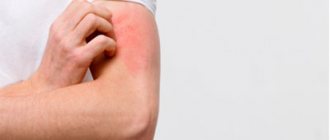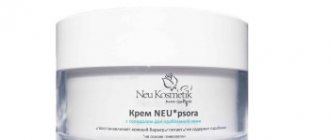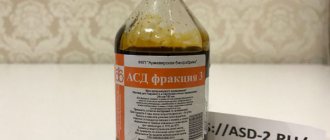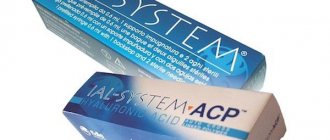Author
: Grachev Ilya Illarionovich
Editor
: Efremov Mikhail Mikhailovich
Date of publication: 09/25/2018 Date of update: 06/08/2020
Very often, the manifestations of psoriasis on the skin of the hands are local in nature, without spreading to the surrounding tissues. With this course, many patients do not pay attention to the rash and do not rush to consult a doctor. But in vain, because in the presence of provoking factors, a “fire” can break out instantly in the form of severe complications, the treatment of which is far from as simple as single psoriatic plaques. Doctors at the Moscow Paramita clinic are well aware of how and how to treat psoriasis on the hands. From this article you can learn how this disease is treated at the initial stage and in severe cases.
Why does psoriasis start on the hands?
Psoriasis on the hands in the form of single regular plaques is only a seemingly local pathological process. In fact, even 1-2 elements of the rash indicate the presence of a chronic inflammatory skin disease. Medicine has not yet been able to unravel all the mysteries of this disease. The exact causes of psoriasis have not been identified. It is only known that the pathological process is based on burdened heredity and immune disorders.
Currently, the genes responsible for the hereditary transmission of predisposition to psoriasis, including on the hands, are being identified and studied. Under the influence of genes, a change in metabolism occurs and a decrease in the content of enzymes that destroy substances involved in inflammatory reactions.
Immunity is also impaired, which leads to a multiple acceleration of cell division in the surface layers of the skin. The cells do not have time to mature when new underlying cells push them to the surface. This is another cause of psoriasis on the hands.
Psoriasis of any localization can spread throughout the body, so do not delay treatment.
See how easily the disease can be cured in 10-12 sessions.
Such changes lead to the appearance of characteristic symptoms of the disease. What does psoriasis look like on the hands? Initially, a scaly spot appears on the hands, sometimes on other parts of the body, which quickly turns into a papule with a raised inflammatory base. The papules grow and merge, forming huge plaques.
But not all genetically predisposed people develop the disease. The reason is the lack of exposure (or minor exposure) to provoking factors. If you avoid these factors, you may never get sick, even if both parents have psoriasis.
Factors that provoke the onset of psoriasis on the hands
Factors that contribute to the development of hand psoriasis are divided into general and local. Common factors include:
- sedentary lifestyle, overweight, obesity;
- hormonal imbalances; the hormonal system is one and a failure in one link will certainly lead to numerous disorders in the body, including metabolic and immune disorders;
- improper irregular nutrition, consumption of large amounts of high-calorie food, meat, sweets;
- bad habits – smoking, alcohol abuse;
- prolonged stress, high mental and physical stress;
- What matters are long-term chronic diseases and foci of infection that contribute to the development of intoxication, under the influence of which metabolism is disrupted.
Red spots on the skin after stress
Diagnosis of skin diseases
Very often, psoriasis on the hands is provoked by the following local factors:
- constant mechanical injury to the skin of the hands - abrasions, scratches, wounds;
- frequent exposure of the skin to various chemicals: household chemicals, industrial hazards, etc.;
- constant exposure to the cold - this leads to spasm of small blood vessels and disruption of skin nutrition; therefore, disruption of metabolic processes is only a matter of time;
- any skin infections - bacterial, fungal, viral.
The most common skin diseases
There are many skin diseases. All of them spoil the appearance and cause discomfort, and some are fraught with dangerous consequences, so it is important to diagnose and treat them in a timely manner.
The most common skin diseases include:
- acne;
- dermatitis;
- herpes;
- lichen;
- papilloma;
- scabies;
- bedsores.
Acne is a disease that teenagers and young adults often experience. It is characterized by the appearance of acne and purulent follicles localized in the face, chest and shoulders. Acne greatly spoils the appearance and rarely goes away without a trace: scars, irregularities and spots remain on the skin, which are then almost impossible to get rid of, so treatment of the disease must be started as early as possible.
Dermatitis is an inflammation of the skin accompanied by redness and itching. Can be localized almost anywhere. This skin disease can be caused by various reasons, from mechanical damage to a disruption in the functioning of internal organs. Depending on the reasons that provoked it, several types of dermatitis are distinguished: atopic, contact, seborrheic.
Herpes is characterized by the formation of blisters containing clear liquid on the surface of the skin. The affected area hurts and itches, and a few days after the blisters burst, a yellowish crust forms in their place. The lips, nose and genitals are most often affected. The disease is caused by the herpes virus, which infects most of the world's population and is activated by favorable factors: decreased immunity, metabolic disorders, alcohol abuse, etc.
Ringworm appears as colored or scaly patches on any part of the body, including the scalp under the hair, causing partial baldness. Ringworm can be caused by various pathogens, so for effective treatment it is necessary to accurately determine the cause. There are several types of lichen: ringworm, scaly, candidiasis and others.
Papilloma is manifested by the formation of small growths and warts on the skin. Since the formation of growths is caused by pathological proliferation of cells, in medicine it is customary to classify the disease as benign tumors. Papillomas can be localized almost anywhere. The greatest discomfort is caused by papillomas on the face, which greatly spoil the appearance. Due to their structure, papillomas are often injured, which can lead to further growth and even development into a malignant tumor.
Scabies, as the name suggests, is manifested by severe, unbearable itching. Next, redness and stripes appear on the skin, the so-called scabies. The disease occurs as a result of infection with scabies mite, which is not visible to the eye, but is easily transmitted from person to person, including through household objects.
Bedsores are formed as a result of necrosis of soft tissues due to disruption of their nutrition. Often appear in bedridden and partially immobile patients. They manifest themselves as redness and swelling of the skin, the formation of blisters, which subsequently turn into ulcers. Bedsores are dangerous because they grow quickly and can destroy soft tissue right down to the bones.
There are many other skin diseases: eczema, dermatomycosis, melanoma, carcinoma, keratosis. In the early stages, most of them can be successfully treated, so the importance of timely diagnosis cannot be underestimated.
Symptoms of psoriasis on the hands
The disease can begin and progress differently depending on the form. Symptoms of psoriasis on the hands can also vary.
Vulgar form
This is the most common form. On the hands, the skin of the extensor area of the joints, as well as the forearms, wrists, dorsum of the hands, and fingers are usually affected. In the area of the elbows, so-called standby plaques appear on both sides, which can remain in the same state for years without progressing. On the back of the hands, the disease progresses more often, since the skin in these areas is constantly exposed to various influences. Psoriasis often appears on the fingers. In case of damage to the little fingers and thumbs, the risk of injury to psoriatic elements increases.
The first signs of psoriasis on the hands are the appearance of one or more scaly spots, which quickly turn into papules with a raised inflammatory base. If you scratch the top of such a papule, a number of characteristic symptoms appear:
- type of stearin drop - multiple white flakes;
- if you scrape off all the scales, a transparent film will be visible;
- Slightly scraping the film leads to the appearance of droplets of blood on it.
These symptoms are the hallmark of a psoriatic rash. In the future, the primary symptoms of the disease may progress, with the papules increasing in size, merging with each other and forming large plaques, and new elements appear. Possible damage to nails. Over time, the progression stops, after which the recovery process begins: the rash slowly turns pale and disappears.
Exudative form
This form of the disease is less common. The skin on the back of the hands is usually affected. Often this type of psoriasis also affects the fingers. Characterized by the appearance of swelling, exudate on the surface of the rash elements, severe itching and a constant feeling of discomfort. As a result, the scales stick together to form grayish-yellowish crusts on the surface of the papules on the skin of the hands and fingers. In this case, peeling is not very noticeable, but the risk of bacterial infection increases. What exudative psoriasis looks like on the hands can be seen in the photo:
Palm shape
Psoriasis on the palms can occur in the form of plaque-fan-shaped, horny and pustular forms.
The plaque-fan-shaped form is characterized by the formation at the initial stage of rash elements in the form of scaly papules, merging into large plaques. The rashes are localized mainly on the palms and fingers. It often recurs and is difficult to treat. The reason for this is the constant exposure to various external factors. The skin between the fingers is affected. They turn red, swell, and become covered with cracks and scales. Often such rashes spread to the fingertips and nail plates.
The horny form is manifested by dry skin, thickening on the palms, the appearance of cracks and dry calluses.
Psoriasis on the palms of the hands may look like pustules. This is the so-called Barber pustular psoriasis. Purulent blisters appear on the surface of the palms, which can merge with each other, forming purulent lakes. The contents of the pustules are sterile. Photo:
Skin specialist
The skin acts as a natural barrier, protecting the body from harmful environmental influences. It also takes part in the thermoregulatory process and metabolism, and is responsible for sensitivity to pain and temperature changes. It happens that the skin reacts to stressful situations, poor nutrition, lack of vitamins, pathologies of internal organs, as a result of which noticeable signs and often painful symptoms appear. Skin diseases can also occur due to infections or parasitic insects.
To determine the cause of the deterioration of the skin condition and cure the disease, you need to consult a skin specialist - a dermatologist. This doctor examines the skin, diagnoses and treats skin diseases.
In what cases is it necessary to consult a specialist in skin diseases?
As a rule, dermatological diseases are not life-threatening, but they cause significant inconvenience to people. Patients experience unpleasant itching, acne, redness and other external imperfections that are very difficult to hide. As a result, people begin to experience psychological discomfort, become depressed, lose their appetite, experience insomnia, and disrupt the functioning of the immune system. If treatment for the disease is not started in a timely manner, it can develop quite rapidly, leading to serious complications and disruptions in the functioning of internal organs.
It is advisable to make an appointment with a skin specialist if you have the following symptoms:
- disruption of the sebaceous glands, too oily skin;
- dry skin with frequent peeling;
- change in skin tone;
- the appearance of warts or new moles;
- the appearance of ulcers, erosion, red spots, purulent formations;
- brittle nails, etc.
You should not self-medicate for skin diseases. Most of them are triggered by the penetration of a viral infection, bacteria or fungi. Sometimes dermatological diseases arise due to problems in the functioning of internal organs. Then the patient needs complex diagnostic and therapeutic procedures under the supervision of not only a skin specialist, but also other doctors.
What diseases does a dermatologist treat?
Skin disease specialists diagnose and prescribe treatment for the following pathologies:
- the appearance of warts, condylomas, herpes, molluscum contagiosum and other formations caused by viral infections;
- impetigo, pyoderma caused by bacterial infections;
- mycoses, various types of lichen, candidiasis and other diseases caused by fungal infections;
- scabies, pediculosis, resulting from exposure to parasites on the skin.
Skin specialists also help patients in getting rid of various non-communicable diseases that are associated with skin, nails and hair problems: psoriasis, eczema, acne, atopic dermatitis, lichen planus, rosacea. Dermatologists also remove benign skin formations, such as keratomas, papillomas, lipomas, moles, etc.
To restore and improve the condition of the skin, doctors prescribe cosmetic procedures. For preventive purposes, to prevent negative changes, a skin specialist can recommend special diets and effective cosmetics that will help maintain the elasticity and healthy appearance of the skin.
What does an appointment with a skin specialist include?
When coming for a consultation, the patient tells the doctor about the presence of unpleasant symptoms. The doctor listens carefully to him, then conducts a thorough examination of the affected areas of the body, writes out a referral for tests or diagnostic procedures. The dermatologist selects diagnostic methods depending on the nature of the disease. The specialist can ask the patient questions about the presence of hereditary diseases, lifestyle, bad habits, and medications taken. The doctor visually assesses the condition of the skin, the nature and extent of the pathology. If necessary, he performs non-surgical dermatoscopy and scraping from the affected area.
If the dermatologist decides that the cause of the pathology is caused by disturbances in the functioning of the internal organs, he will recommend the patient to visit another specialist, for example, an endocrinologist, immunologist, gastroenterologist, etc.
How is treatment done by a dermatologist?
Treatment of skin pathologies can be complex and include both medication and physiotherapeutic treatment, as well as modern surgical methods.
In many cases, the patient only needs to be prescribed medications. Depending on the type of pathogen, location of spread and phase of development of the disease, the doctor may prescribe anti-inflammatory, antiviral, antifungal drugs, and drugs that strengthen the immune system. Sometimes treatment includes a course of injections and IVs. Some pathologies are treated with external medications: ointments, creams, gels, etc.
Physiotherapeutic treatment is widely used for the treatment of skin diseases. It is especially effective for psoriasis, eczema, acne, herpes, etc. Among physiotherapy methods, UHF, ultraphonophoresis, inductothermy, medicinal baths and other procedures are often used.
Surgical intervention is needed to get rid of benign neoplasms: moles, papillomas, warts, etc. Modern surgical techniques allow you to achieve an excellent aesthetic effect, these include:
- cryodestruction;
- radio wave surgery;
- laser removal.
Treatment of skin diseases
In our clinic, experienced, highly qualified specialists provide diagnosis and treatment of skin pathologies. They provide physiotherapy and surgical procedures using state-of-the-art quality equipment.
To make an appointment with a dermatologist and find out the cost of services, call or fill out the feedback form on the website.
Author
Turchaninova Kristina Valerievna
cosmetologist, dermatologist, dermatovenerologist
10 years of experience
+7
Treatment methods for psoriasis on the hands
How to treat psoriasis on the hands? This problem arises immediately after diagnosis. Experts recommend comprehensive treatment, which includes:
- changing lifestyle, daily routine;
- getting rid of bad habits;
- proper nutrition;
Lifestyle recommendations
Patients with psoriasis localized on the hands need to:
- regulate wakefulness and sleep patterns;
- engage in feasible sports; Activities such as outdoor running, swimming, tennis are welcome; avoid contact sports (wrestling);
- important: after playing sports, be sure to take a shower - sweat irritates the skin and can provoke an exacerbation of the pathological process;
- wash only with soft washcloths using hypoallergenic detergents;
- After a shower, apply moisturizer to your body;
- use underwear made from cotton fabrics;
- in the cold season, wear gloves (mittens) with flannel lining;
- Avoid contact with household chemicals and any other chemicals.
Drug therapy
Good to know
- Treatment of psoriasis on the head
- Treatment of psoriasis on the elbows
- Treatment of psoriasis on the legs
- Treatment of psoriasis on nails
- Treatment of psoriasis on the face
- Treatment of palmoplantar psoriasis
In mild cases, psoriasis on the hands is treated locally, using various external agents and procedures. Prescribed:
- keratolytics - medicinal ointments and creams that dissolve surface layers of dead epithelial cells (salicylic acid);
- emollients (tar-based psoriasis ointment);
- synthetic analogues of vitamin D (calcipotriol);
- synthetic analogues of vitamin A (retinoids);
- glucocorticosteroid (GCS) hormones - allow you to treat all forms of hand psoriasis;
- combination products that include GCS + salicylic acid (Diprosalik) or GCS and calcipotriol (Daivobet);
- creams and ointments with active zinc;
- medicinal baths with herbs (celandine, chamomile, calendula).
If the symptoms of psoriasis on the hands do not go away, the disease progresses, and general therapy must be prescribed. It should be carried out in a hospital setting:
- droppers with medicinal solutions that eliminate intoxication;
- injections of drugs that remove toxins (Unitiol, magnesium sulfate);
- desensitizing (eliminating allergies) and sedatives; 1st generation antihistamines (Suprastin, Tavegil) are most suitable;
- glucocorticoids - taken orally or by injection - have a pronounced anti-inflammatory and desensitizing effect, relieve itching;
- cytostatics - drugs that suppress too frequent division of epithelial cells;
- Immunosuppressants are medications that suppress the excessive sensitivity of the immune system.
Unique methods for treating psoriasis on the hands
The Moscow Paramita Clinic is a leader in the treatment of such a complex form of the disease as psoriasis on the hands. Experienced specialists who have undergone all the necessary training in the treatment of this disease try to take an individual approach to the treatment of each patient, using the most effective methods.
- PRP therapy is a method that has been used relatively recently, but has already gained well-deserved popularity, as it is very effective and safe; the method consists of enriching the patient’s blood taken from a vein with platelets and injecting it into the affected areas on the skin of the hands;
- autohemotherapy is a method that has been tested for decades: blood is taken from the patient’s vein and injected intramuscularly; excellent stimulating effect;
- herbal medicine – the use of medicinal plants using modern methods;
- reflexology – exposure to certain points on the body using various methods (acupuncture, massage, cauterization, etc.); exposure to one point or another has a reflex effect on the condition of the skin;
- vacuum therapy is one of the types of reflexology, when certain points and zones are affected using vacuum.
The clinic’s dermatologists prescribe complex therapy taking into account the patient’s age, general condition, the presence of certain concomitant diseases, as well as the nature of the course of psoriasis. As a result of this approach, the patient receives the necessary treatment for psoriasis in Moscow without side effects, which allows him to get rid of the symptoms of the disease for a long time.
To avoid relapses, it is necessary to eliminate the cause of the disease.
Read more about our unique method of treating psoriasis
Patients return to the clinic again and again for maintenance anti-relapse treatment and live for years without exacerbations. In the reviews, they note the high professionalism and attentive attitude of the doctors.
Sign up for a free initial appointment
Diagnosis and treatment of skin diseases
A dermatologist diagnoses and treats skin diseases. In dermatology there are narrower specializations: dermatovenerologist, dermatocosmetologist and trichologist. If symptoms of skin diseases appear, you can first contact a therapist; he will tell you which specialist to contact in a particular case. To make an accurate diagnosis, a number of laboratory tests are often required, these may include: blood, urine and stool tests, serological culture, scraping, smear, biopsy.
In Volgograd, Volzhsky and Mikhailovka with symptoms of skin diseases, you can contact the DIALINE clinics. Experienced dermatologists using the latest diagnostic methods await you. To make an appointment, use your personal account on our website, where you can make an appointment at any of our clinics at a time convenient for you.
Stages of hand psoriasis
The disease occurs in alternating phases of relapses and remissions. The course can be severe, moderate or mild. During an exacerbation, the disease goes through several stages. Psoriasis on the hands, stages:
- the initial stage of progression - a psoriatic rash appears, the symptoms of the disease quickly increase;
- stationary – no new elements appear, the rashes do not fade or become smaller;
- regressing - the rash turns pale, swelling subsides, all signs of exacerbation disappear, and gradually only white or brownish spots remain on the skin, which also disappear over time.
Any form of the disease, in the absence of adequate treatment, can be complicated by joint damage and erythroderma - inflammation of large areas of skin with severe swelling and redness.
When to consult a dermatologist
Symptoms of skin diseases can be very different. It is worth consulting a dermatologist if you experience:
- swelling of the skin, itching;
- if there are boils or pustular formations on the skin;
- if the skin turns red and peels;
- weeping, inflamed areas of the body;
- hair falls out intensively, splits;
- blackheads, acne;
- The nail plate began to crumble and the color changed.
Even one of the listed symptoms is a reason to visit a dermatologist. Almost all diseases are treatable. It is important not to waste time so that the pathology does not become chronic.
Common symptoms and manipulations in dermatology:
- Skin rashes
- Calling a dermatologist to your home
- Itching in the urethra
- Itchy skin
- Skin rash
- Prevention of casual sex
- Skin neoplasms
- Pyoderma
- Pityriasis rosea
- Streptoderma
- Scabies
- Peeling skin
- Fungal infections
- Skin infection
- Pus on the skin
- Blisters on the skin
- Papillomas on the foreskin
- Sexually transmitted diseases
- Skin structure
How to eat healthy
Nutrition is of particular importance as it affects metabolism, the disturbances of which underlie the disease. It is useless to treat psoriasis without following a diet. Important: in the patient’s diet, 70% should be products of plant origin and only 30% should be animal products. Recommended to use:
- any fruits and vegetables (fresh, boiled, stewed) except those prohibited;
- fresh juices; Citrus juices are especially useful; lemon juice can be used as a salad dressing;
- more clean water.
Limit consumption (no more than a few times a week):
- lean meat and fish;
- low-fat cottage cheese and fermented milk products;
- cereals;
- some fruits and berries: plums, currants, cranberries, blueberries.
Exclude from the diet:
- fat meat;
- fatty dairy products;
- sweets, baked goods;
- vegetables from the nightshade family: tomatoes, eggplants, hot and bell peppers;
- all spicy, sour, smoked, fried, canned foods;
- drinks: sweet soda, cocoa, strong coffee, tea, alcohol.
Treatment of psoriasis on the hands with folk remedies
Folk remedies are widely used in the treatment of psoriasis on the hands. Celandine is especially often used for this purpose. For example, a serum infused with celandine helps a lot.
You need to take a glass of crushed fresh celandine herb, wrap it in a cotton napkin, tie it, put it in a 5-liter glass jar, fill it with three liters of whey, add 200 g of sugar, 20 g of sour cream and leave in a warm place for 15 days: during this time the whey will ferment ; this serum should be filtered and taken 70 ml in the morning 30 minutes before meals; store in a cool place; perfectly removes toxic substances, cleanses the body, activates metabolism; the symptoms of the disease go away.
Prevention of psoriasis on the hands
Prevention of the disease includes patient compliance with recommendations on daily routine, skin care and nutrition.
Psoriasis on the hands is best treated in the early stages of the pathological process. It is impossible to completely cure this process, since under the influence of any factors a relapse may begin. But if maintenance treatment is carried out periodically, remission for a long time is quite possible. At the same time, the person lives life to the fullest and does not remember relapses.
How does the treatment proceed?
Treatment of skin diseases consists of several stages:
- elimination of external manifestations;
- strengthening the immune system;
- normalization of the functioning of internal organs and the lymphatic system.
Dermatologists at our clinic successfully use both complex medicinal treatment of internal organs and skin, as well as herbal medicine, homeopathy, cryotherapy, etc. In some cases, skin inflammation is local in nature. For example, you can visit our clinic and undergo felon treatment at an affordable price at any time convenient for you.
DAY CARE SERVICE










